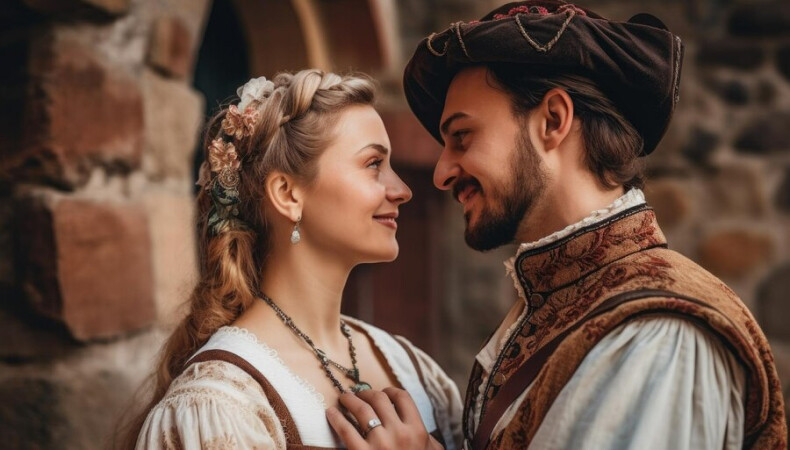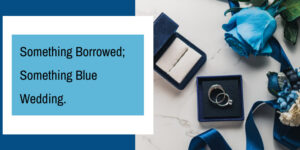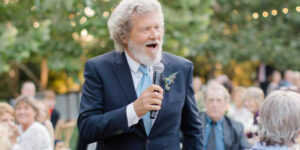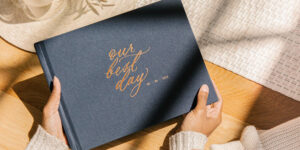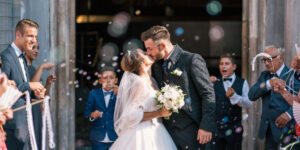Step back in time and immerse yourself in the rich and captivating world of Viking wedding traditions. Descending from the seafaring warriors of the past, Viking weddings were not just mere ceremonies but grand celebrations of love, honor, and unity. These weddings were marked by a blend of symbolism, superstition, and deep-rooted customs that bound couples together for life.
From the intricate weaving of love knots to exchanging powerful tokens, every element of a Viking wedding held profound significance. Join us on a journey to explore the fascinating rituals that shaped the bonds of matrimony among the fierce and fearless Norse people.
History of Viking Wedding Traditions
Viking wedding traditions were rooted in the rich history of Norse culture, which flourished during the Viking Age (approximately 793 to 1066 AD). Marriages held immense significance, uniting families, clans, and tribes to form alliances and strengthen social ties. The ceremonies were often conducted in sacred locations like groves or near water bodies, invoking the blessings of the gods.
Handfasting, the binding of the couple’s hands with cords, symbolized their commitment. Feasting, storytelling, and games brought joy to the celebrations. Offerings to deities and the exchange of valuable gifts sealed the matrimonial bond. These time-honored customs reflected the Vikings’ deep reverence for love, honor, and the natural world.
What are Viking Wedding Traditions?
Viking wedding traditions were deeply rooted in Norse culture during the Viking Age. Marriages held immense social and familial importance, often involving elaborate rituals. Handfasting was a central tradition, where the couple’s hands were bound with cords, symbolizing their commitment and unity.
The exchange of swords or rings symbolized the groom’s pledge to protect his bride. Feasting and drinking mead played a significant role in the celebrations, fostering community and goodwill. Offerings to Norse gods sought their blessings for a prosperous marriage. Viking weddings were not just ceremonies but grand festivities that celebrated love, honor, and the bonds of kinship.
15 Viking Wedding Traditions To Know
1. Handfasting
Handfasting, a revered Viking wedding tradition, has seen a modern resurgence, captivating couples seeking a meaningful union. In this ritual, the couple’s hands are ceremoniously bound with cords or ribbons, symbolizing their commitment and unity. Each strand represents different aspects of their bond, like love, trust, and support.
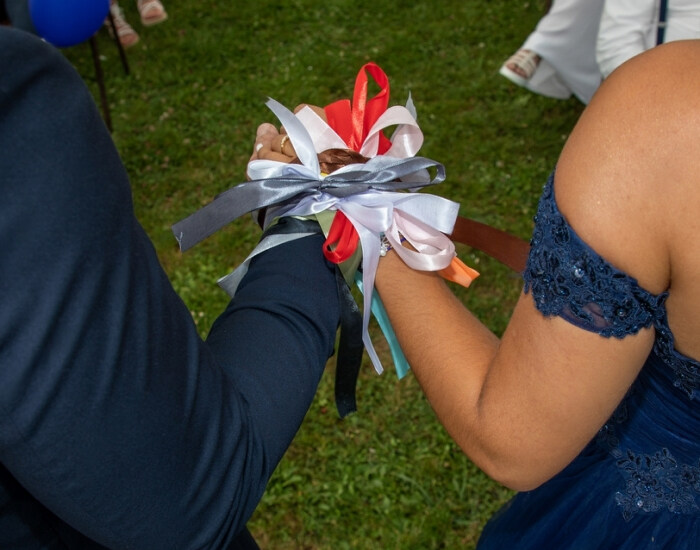
Source: Adobe Stock
The couple’s lives are forever entwined as the cords are intertwined, promising to walk life’s journey together. This contemporary adaptation allows couples to infuse personal touches, such as using meaningful colors or incorporating family heirlooms into the handfasting cords, making it a unique and cherished symbol of their love and devotion. It’s one of the unique Norse wedding traditions.
Also See: Handfasting Ceremony: A Beautiful Wedding Tradition
2. Runestones Exchange
The ancient Viking tradition of exchanging runestones has been ingeniously revived as a modern and deeply personal wedding custom. Instead of reciting traditional vows, the couple exchanges engraved runestones with heartfelt and personalized messages, expressing their promises and love for each other.
These ancient symbols carry profound significance, and each rune holds a unique meaning, representing various aspects of life, love, and the future. The runestones become treasured keepsakes, reminding the couple of their commitment and sacred bond. This thoughtful and unique exchange of runestones adds a touch of mystery and enchantment to the wedding ceremony, making it truly unforgettable.
3. Animal Sacrifice
The Vikings practiced animal sacrifice as a significant part of their wedding rituals to seek blessings from their fertility gods. During the ceremony, the bride’s family paid a dowry to the groom’s family, followed by a religious invocation to summon the gods and goddesses—animal sacrifices play a pivotal role in this process, symbolizing offerings to specific deities.
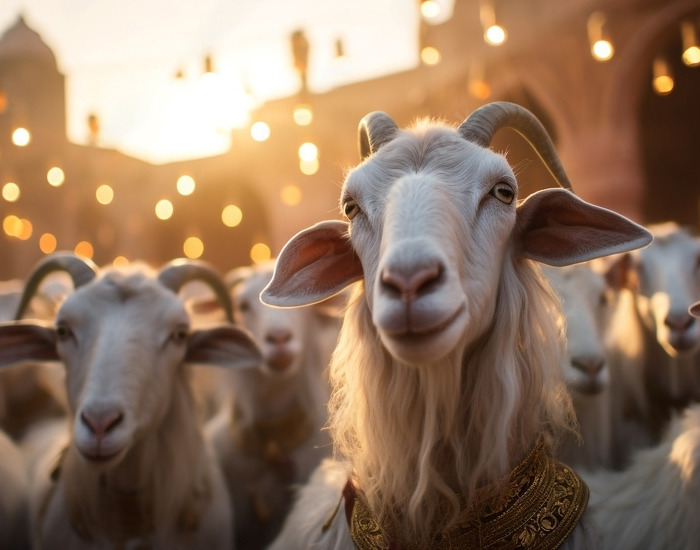
Source: Adobe stock
For Thor, a goat was slaughtered; for Freyja, a sow was sacrificed; for Freyr, a horse or a boar was offered. The Gothi, responsible for the wedding, conducted the sacrifices. The couple received blessings as the animal’s blood was sprinkled on them, invoking divine favor for their future together.
4. Frigga’s Day
Viking weddings held special significance as they were exclusively scheduled on FriggaDayday, corresponding to our modern-day Friday. Frigga, the revered Norse goddess of marriage, love, and fertility, presided over these joyous occasions.
As the wife of Odin, a prominent deity known for his wisdom, healing, magic, and association with various aspects of life, Frigga’s blessings were sought to ensure a prosperous and fruitful union. The choice of Friday as the wedding day was a tribute to the divine powers of Frigga, believed to bring good fortune, happiness, and harmony to the newlyweds. This sacred tradition-bound couples in the eternal embrace of love and divine favor. It’s one of the unique Norse wedding traditions.
5. Drinking Horn Toast
The Drinking Horn Toast is a cherished Viking wedding tradition, observed during the festive reception. As the couple and their guests gather, they raise drinking horns brimming with mead or other libations to celebrate the happiness and future of the newlyweds.
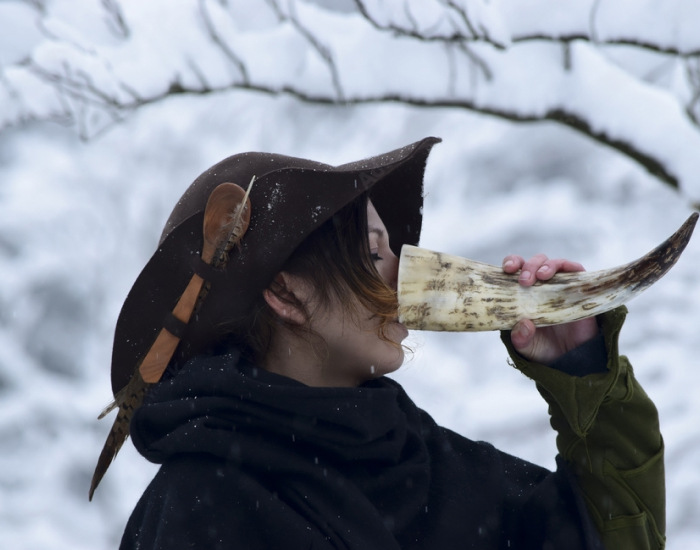
Source: Adobe stock
This age-old custom represents sharing joy, camaraderie, and blessings for the pair’s journey. The clinking of the drinking horns resonates with the spirit of the Vikings, who valued unity and the bonds of kinship. Through this heartfelt ritual, the couple is embraced by the warmth and goodwill of their loved ones, creating cherished memories that will endure throughout their married life. It’s one of the unique Norse wedding traditions.
6. Viking Feast
At Viking Fest, the ambiance was nothing short of enchanting. The celebration occurred in a rustic and natural setting, often amidst lush forests or near the captivating allure of fjords and lakes. The venue was adorned with torches, creating a warm and inviting glow that beckoned guests to immerse themselves in the magical atmosphere. Long wooden tables were arranged, hearkening back to Viking feasts of old, promoting a sense of community and togetherness.
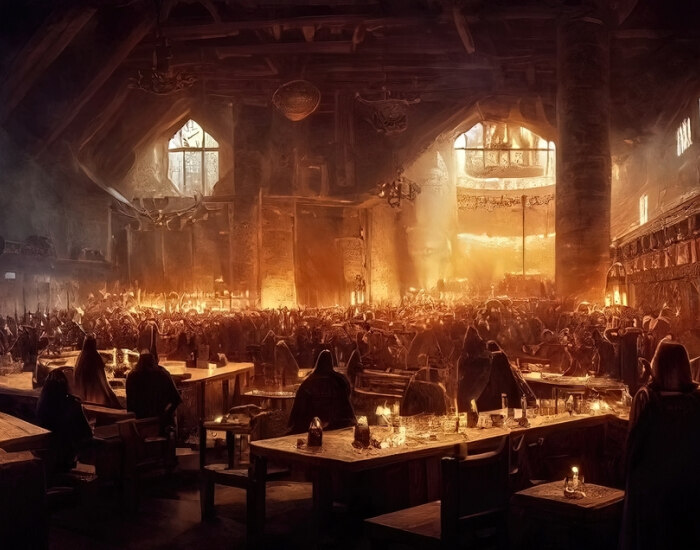
Source: Adobe stock
As for the culinary delights, the feast was a true testament to Viking hospitality. Guests indulged in hearty and delectable dishes featuring roasted meats such as lamb, venison, and boar, reflecting the abundance of the land: hearty stews and savory pies accompanied by freshly baked bread filled the air with enticing aromas.
Drinking horns brimmed with mead, the ambrosial honey-based beverage, flowing freely, toasting to the couple’s happiness and future. The exquisite setting and sumptuous fare created an unforgettable ambiance, making Viking Fest a celebration steeped in tradition and warmth.
7. Exchanging swords
Incorporating the age-old tradition of exchanging swords adds a captivating touch to Viking weddings; as a symbol of transferring protection between the two families, the bride and groom exchange swords to reinforce their newfound alliance. This ritual held deep significance to the Vikings, signifying the merging of two households and the commitment to safeguard each other.
Alongside the sword ceremony, the exchange of rings also held importance, symbolizing the couple’s union, much like in contemporary weddings. These meaningful customs reflect the rich heritage of the Vikings, where the bonds of love, loyalty, and protection were woven into the fabric of their matrimonial celebrations.
8. Wedding Hair
In Viking culture, bridal wedding hair held immense significance, representing the bride’s sexuality and femininity. More vital than the wedding dress, the hairstyle was a focal point of the bride’s appearance. The bridal crown passed down from mother to daughter was a cherished heirloom.
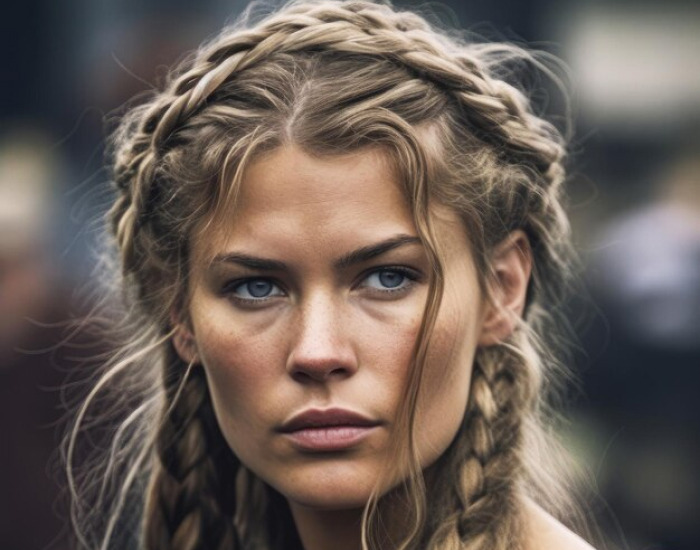
Source: Freepik
This crown was intricately adorned with various embellishments, including flowers, straw, wood, crystals, and other precious materials that held cultural or sentimental value. The artistry of creating these crowns showcased the community’s skill and creativity, and the bride wore them with immense pride and honor. This ancient tradition emphasized celebrating a woman’s beauty and identity on her special day. It can also be included in modern Viking wedding traditions.
9. Wedding Clothing
While the Vikings emphasized bridal hair, wedding clothing also influenced their matrimonial customs. Although not as central as the hair, brides likely donned vibrant red dresses, a popular color during that era, to symbolize love and passion. Alongside red, other favored colors for wedding attire included blue, green, and yellow, reflecting the diverse palette of the Viking age.
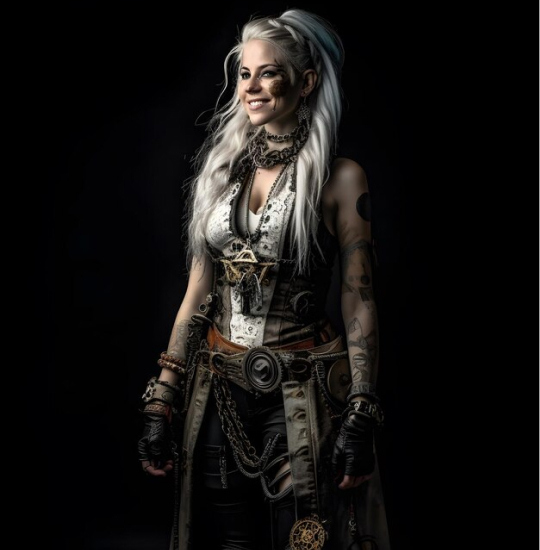
Source: freepik
The choice of color was essential, as it conveyed meaning and cultural significance. These distinct hues added an element of beauty and cultural identity to the bride’s appearance, complementing the grandeur of Viking wedding celebrations. It can also be included in modern Viking wedding traditions.
10. Bride running ritual
After the wedding, an exhilarating bride-running ritual ensued among the bride and groom’s relatives. The two families would race joyfully to the mead hall, eager to claim victory. The tradition dictated that the family who arrived second would graciously serve drinks to the winning family for the wedding festivities.
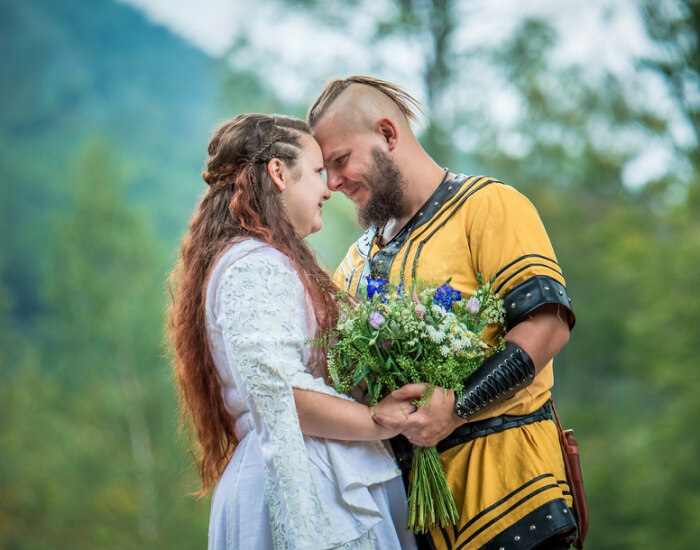
Source: pinterest
This lighthearted competition added fun and camaraderie to the celebration, fostering an atmosphere of joy and merriment. The bride running ritual symbolized the friendly union of the two families, cementing their bond and ensuring a harmonious start to the couple’s new life together.
11. Bridal crown
In the enchanting world of Norse culture, bridal crowns held a cherished place during wedding ceremonies. Crafted from precious metals, these ornate crowns featured intricate designs, often adorned with symbols of fertility, like animals and plants, signifying the couple’s hopes for a fruitful union.
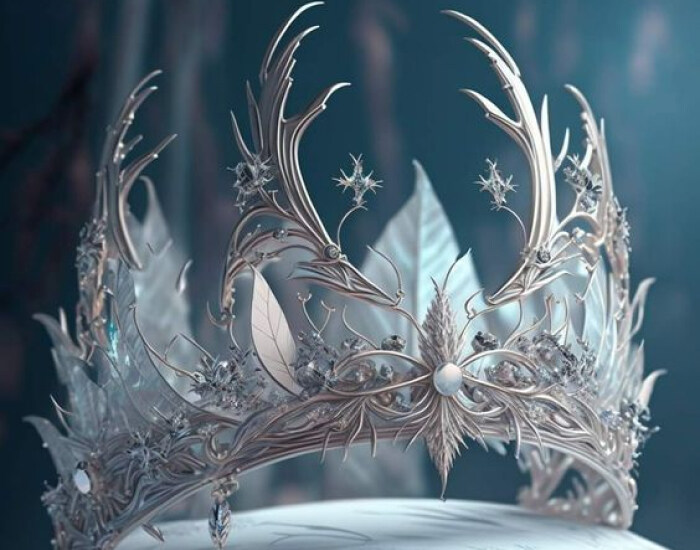
Source: pinterest
A delightful tradition emerged where the bride and groom might wear distinct crowns, each symbolizing their unique qualities and virtues. After the ceremony, the crowns were lovingly placed on the couple’s bedpost, signifying the beginning of their journey as a married couple. This practice symbolized their commitment to love, honor, and fertility, creating a beautiful and meaningful tradition for future generations.
12. Oathing Stones
The ancient ritual of Oathing Stones held profound significance in Viking weddings. As the couple stood before their loved ones, they touched a substantial stone, cementing their promises and pledging their commitment to one another. This act symbolized a sacred connection to the earth, signifying the strength and permanence of their vows.
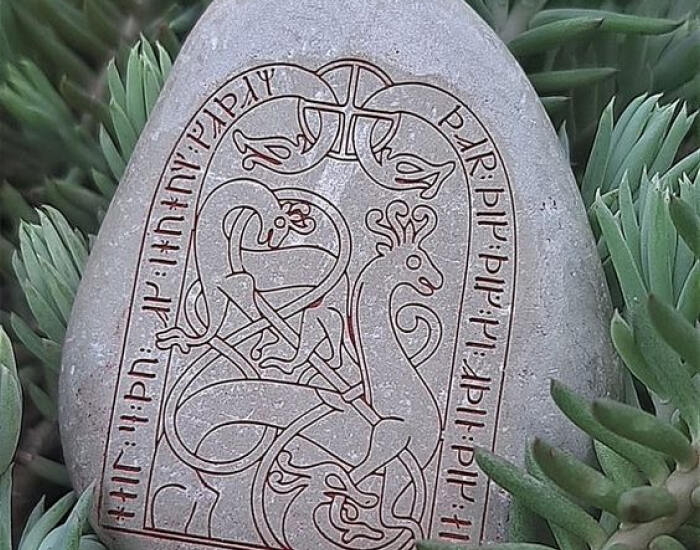
Source: pinterest
The Oathing Stones represented a bond with nature itself, drawing on the timeless power of the land to witness and uphold their union. This beautiful tradition emphasized the depth of their commitment and the enduring nature of their love, ensuring that their promises would stand firm like the unyielding stone.
13. Ceremonial Preparations for Women
Before a Viking wedding, the bride received support and care from her close married female relatives and friends. They participated in two significant ceremonies: the removal of the Fransen and a cleansing ritual. The Fransen was a symbolic circle worn by Scandinavian girls to signify their virginity. However, for the wedding, the Fransen was replaced with a magnificent bridal crown, often a cherished family heirloom.
The crown, typically made of silver and adorned with crystals, would be further embellished with flowers by the bride and her attendants. The bride underwent a cleansing ritual at a bathhouse to prepare for the wedding, signifying the transition from maidenhood to married life.
14. Ceremonial Preparations for Men
In preparation for their Viking weddings, men engaged in unique and symbolic pre-wedding rituals. The groom would symbolically “steal” a sword from an ancestor’s grave to mark their transition from boyhood to manhood. This act represented the shedding of their youthful selves and embracing the responsibilities of adulthood. It served as a rite of passage, signifying the groom’s readiness to protect and provide for his future family.
Similarly, like the women, men also participated in cleansing rituals. These ceremonies aimed to wash away their bachelorhood, purifying them for the sacred union ahead. The cleansing process symbolized a fresh start as they prepared to embark on a new journey as husbands and fathers. These ancient customs enriched the Viking wedding experience, infusing it with a profound sense of tradition and significance.
15. Post-Ceremony Was All About Fertility
Following the ceremony, the Viking wedding reception and honeymoon were replete with ceremonial rituals that revolved around fertility, emphasizing the importance of prosperity and abundance in the couple’s life together.
At the festive reception, a symbolic act awaited the groom. He would thrust his sword into the ceiling, and the depth of his successful thrust would symbolize the enduring strength of their marriage, implying a lasting and fruitful union.
After the wedding, the newlyweds were escorted to their wedding suite by six witnesses. Family and friends lovingly gave them ample honey mead to last a month. The term “honeymoon” originated from this practice, as the couple would consume the mead over one moon’s cycle, bestowing blessings of sweetness and fertility on their new life together. These rituals celebrated the essence of fertility and prosperity, shaping the foundation of their fruitful and joyous marriage.
In conclusion, Viking wedding traditions were imbued with rich symbolism, deep cultural significance, and a solid connection to nature and the divine. From the exchange of swords and oathing stones, which signified commitment and strength, to the adornment of bridal crowns and the sharing of mead for fertility and abundance, every ritual was purposeful in cementing the couple’s union.
These age-old customs reflected the Vikings’ profound reverence for love, family, and community, making their weddings joyous celebrations and sacred and meaningful occasions. The legacy of these ancient traditions continues to inspire modern couples seeking to embrace their heritage while forging new bonds of love and unity.

